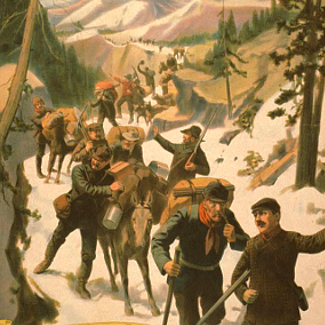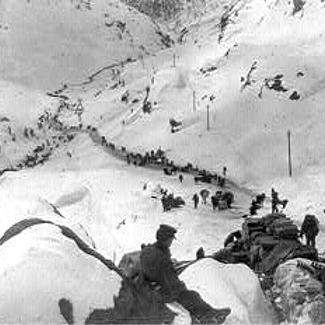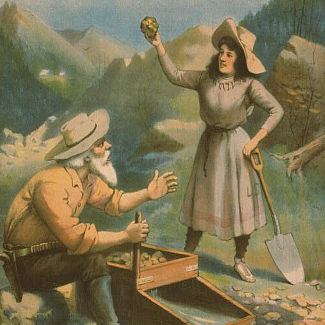-
Klondike Gold Rush

Scene of miners crossing the Chilkoot Pass into the Klondike Gold fields from the play, Heart of the Klondike. Image courtesy Library of Congress.
Associate Pages
-
Visitor Statistics
Klondike Gold Rush NHS - Alaska
Klondike Gold Rush
1,336,008 visitors
#65 Most Visited National Park Unit
Klondike Gold Rush NHS - Seattle
81,652 visitors
#250 Most Visited National Park Unit
Chilkoot Trail National Historic Site - Canada
2,228 backpackers (Dyea to Bennett Lake)
61 day hikers
Source: NPS, Rank among 398 National Park Units 2024. Parks Canada.
Park Size
Klondike Gold Rush NHS - Both
3,420 Acres Federal; 12,996 Acres Total
Chilkoot Trail National Historic Site - Canada
31,877 acres
Park Fees
Free for both U.S. Parks.
Chilkoot Trail NHS - Canada
Day permit, Adult - $9.80C
Chilkoot Trail Permit, Adult - $51.90C, Youth $25.90C, which includes camping fee.
Fees subject to change without notice.
Weather
It's cold here compared to most places you visit, even in Skagway which has a drier and warmer climate than the mountains and interior. You're still only talking highs in the summer of 50's and 60's. It's colder and wetter in other units of the park. Check your day's forecast, dress accordingly, and take enough appropriate supplies for the routine of that day.

Photo above: Miners climbing the Chilkoot Trail. Photo Courtesy Library University Washington; first published in 1900, "The Klondike, a souvenir", Rufus Bucks Publisher, Seattle, 1900 Cantwell, George G. Right: Poster from the play, Heart of the Klondike. Courtesy Library of Congress.

Klondike Gold Rush
What? There was another gold rush. That might be the first thought that most non gold rush oriented historians might state when thinking about the rush for western gold. And yes, that's predominantly because the San Francisco 49ers name keeps the 1849 California Gold Rush and Sutter's Mill in the forefront due to NFL domination. But, in fact, the 1897 Gold Rush from Seattle to the Klondike of Alaska and Canada caused the same amount of fury and fever, and even has a vibrant National Park devoted to it in two states, which trumps the California rush, which only has a state park in Coloma to commemorate its role in western lore. And there's even a Canadian National Park about this one to boot.
Click here to Sponsor the page and how to reserve your ad.

Klondike Gold Rush
It all started on Bonanza Creek on August 16, 1896 when gold was found by George Carmack, Dawson Charlie, and a man named Skookum Jim, and when the news would reach Seattle and San Francisco one year later, the rush was on. One hundred thousand miners would flood the Canadian and American soil from Skagway and Dyea, Alaska to the Yukon River. The first arrived in Skagway on July 29, 1897; within one year that town would be Alaska's largest. They would make boom towns such as Dawson Creek in the Yukon swell from five hundred residents to forty thousand, create towns like Dyea from small trading post to boom then back to bust so fast, your head would swim from the same vertigo many miners felt when climbing the Chilkoot Trail toward the gold fields, and make fortunes of few and disappointment to many. The trip was arduous, a 33 mile walk through steep permafrost terrain from Dyea to Bennett Lake, then a boat trip of five hundred miles. There would be snowslides and less gold than most thought. A railroad was constructed from Skagway to Whitehorse, making the trail itself obsolete. By the time it was completed in 1900, much of the rush would be over. Of the thirty thousand miners who actually made it to the Klondike fields, it's said only four thousand found gold. The fields would be abandoned by 1903, and many had left even before then, back in 1899, when gold was found in Nome. Some who remained would turn to farming land around the boom towns, such as E.A. Klatt, but there was nary a fortune to be found in that.
Just how did they get there once the fever started. There were a variety of passageways from the United States and Canada. Most, however, came to Skagway and onto the Chilkoot Trail or White Pass route. Others came from Edmonton through the Edmonton Backdoor route, from Ashcroft through the Ashcroft Route, the All-American Glacier Route, or a long all-water route that took passengers all the way toward Nome, Alaska, then south down to Dawson City.
Today, most of the history, at least on the American side, focuses on the routes from Skagway or Dyea, and on the history of the towns that boomed, then busted.
Photo above: Mining camp at Bennet Lake, May 1898. Photo courtesy Woodside, H.J., 1858-1929. Library and Archives Canada. Below: Scene of the mountains surrounding Klondike Gold Rush National Historic Site. Courtesy National Park Service.

Klondike Gold Rush Now
There are three park units that focus on the Gold Rush. A small single building Visitor Center in Seattle, which includes the story of how the men began their journey north, prompted by the Gold! Gold! Gold! headline in the newspaper of July 17, 1897. One of the unique features of this small park is a partnership with the Living Voices theatre company, who puts on summer performances of the Klondike, the Last Adventure, a play in the park theatre at 2 p.m. There's limited seating and it's unkown whether this program will be offered other years.
At Skagway, the Visitor Center and over a dozen other restored buildings in the town give a wonderful vision of what life was like in this Klondike Gold Rush decade. There's even the sense of capacity with more than one million visitors coming per year to a town that dips to under one thousand in the winter. If you venture ten miles north to Dyea, you get the real sense of what bust is ... there's almost nothing there to remind you that a gateway to mining city once existed at this trailhead to Chilkoot.
Dyea, Alaska today is an abandoned oasis of forest with few remnants of a vibrant community, now part of a ranger tour from Klondike Gold Rush National Historic Site. Dawson City is more vibrant than that, but certainly not boom, containing just over a thousand citizens today.
T-Shirts and Souvenirs

Klondike Gold Rush T-Shirts and Souvenirs from the official merchandise of America's Best History.

Klondike Gold Rush
Things You Should Not Miss
1. Check in at the Klondike Gold Rush, Skagway Visitor Center, and find out about the ranger tours for the day. The visitor center is located in the historic railroad depot of the White Pass and Yukon Route. From late May to late September, there's a guided tour of the Skagway historic district, with its seventeen restored historic buildings, including three saloons. Yes, the men of the mines had their diversions. If you are at the park from late June to August, there's a ninety minute guided tour of the Dyea abandoned town site. You can visit that on the tour or your own. There's something oddly cool about being in a place that once was and pretty much isn't any more.
2. Both the visitor centers in Seattle and Skagway have films for you to enjoy; Gold Fever: Race to the Klondike in Skagway and Klondike Gold Rush in Seattle. There's also a daily auditorium program at the Skagway Visitor Center for those that like a sit down experience.
3. For those that are experienced hikers, and we do mean experienced, take a walk on the Chilkoot Trail. The entire length is thirty-three miles. It stretches from Dyea, Alaska, to Lake Bennett, British Columbia. During the peak season, you must have a permit to backpack the entire trail. For a day trip, that's not necessary. For others who want to walk the Klondike at a less rigorous pace, there are a variety of trails throughout the park. Ask at the Visitor Center for the trail that might be right for you.
Photo above: Skagway Visitor Center. Courtesy National Park Service.
Visitor FAQ

What's There Now
Klondike Gold Rush Parks
Klondike Gold Rush Visitor Center, Seattle - Twenty-five minute film, mining demonstrations, and Trail to Treasures ranger walk around the Pioneer Square Historic District three days per week in summer.
Klondike Gold Rush Visitor Center, Skagway - Thirty minute film, exhibits, museum, daily auditorium program, and in summer, a ranger-guided walk through town.
Dyea - Located ten miles away, this town which boomed at the head of the Chilkoot Trail, booms no longer. There are few remnants that a thriving community once was located here. That does not mean you shouldn't take the time to visit; the stories of the men who made the place, during and after the boom, are fascinating. Just one of E.A. Klatt, still remains somewhat a mystery.
The Chilkoot Trail - Thirty three miles that was hiked by the miners as they traversed the mountains toward Bennett Lake. Today, if you are an experienced hiker, you can make the same trek.
Chilkoot Trail National Historic Site, Canada - Accessed primarily by through hikers from the USA side, the over thirty thousand acres are a wonder of beauty and harsh nature. You can just imagine this harsh nature while carrying mining equipment. It's possible to train in to the Bennett Lake, Canada side, and day hike or day trip the site, although the journey is expensive, over $200. It is, however, an exclusive and unique trip.
Photo above: Klondike Gold Rush Trail Center, Skagway. Above right. Hiking a trail at Klondike. Both photos courtesy National Park Service.

Directions to the Park
Klondike Gold Rush National History Site, Skagway, Alaska -Not the easiest place to get there by car and it requires international travel to do it. You get to Skagway over the one hundred mile Klondike Highway from Whitehorse, British Columbia. From there, you can connect to the Alaska-Canada highway. For many who come to Skagway, it will be ferry or cruise ship.
Seattle Unit - Located at the corner of 2nd Avenue South and South Jackson Street. Take the James Street exit off Interstate 5 to 5th Avenue for six blocks to South Jackson Street. Turn right for four blocks.
You can not access the full trail from Bennett Lake on the Canadian side. Bennett Lake is only accessible by train, float plane, or boat charter, so it's usually a day trip in and out. A train trip in from Skagway on the White Pass and Yukon Route Railroad to Bennett Lake costs over $200. Arrangements for travel must be made from Skagway, ... yes, even arrangements for pickup after walking the Chilkoot Trail from the United States to Canada side must be made prior to starting. Ask or call about the specifics, it gets a little complicated.
Lodging and Camping
Skagway is a very small town, particularly when the tourists leave before winter, so there's not a great amount of lodging. There are ten motels and bed and breakfasts to choose from. Check out your favorite online lodging site for the lodging type of your choice.
There is a National Park Service campground in Dyea with no facilities other than vault toilets. It rarely fills.

More Photos of the Park

Photo above: Ranger guided tour of the Moore cabin, the oldest cabin in Skagway, built in 1887. Image courtesy of the National Park Service. Next: One half of a stereograph photo of miners as they hike up the Chilkoot Trail from Dyea, Alaska. Courtesy Library of Congress.

About
America's Best History where we take a look at the timeline of American History and the historic sites and national parks that hold that history within their lands.
Photos courtesy of the Library of Congress, National Archives, National Park Service, americasbesthistory.com and its licensors.
- Contact Us
- About
- © 2025 Americasbesthistory.com.
Template by w3layouts.